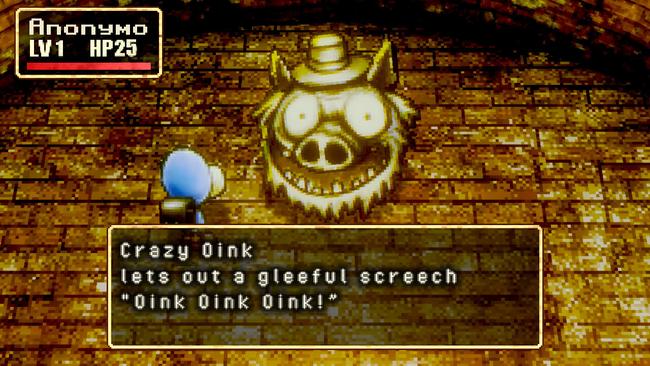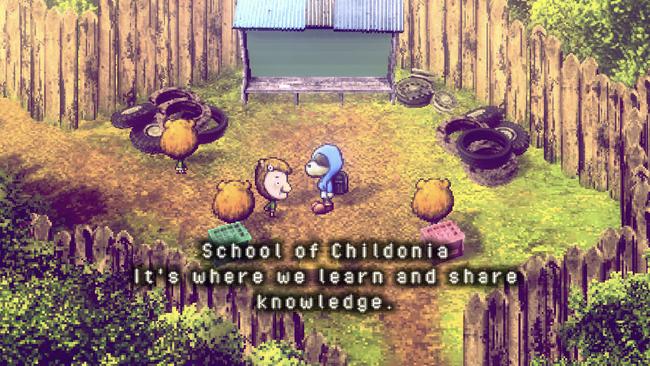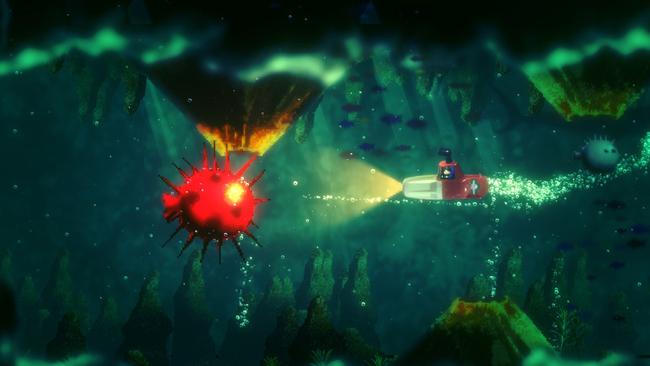
Moon: Remix RPG Adventure was the first game I played from the now-closed studio Love-de-Lic. The PlayStation 1 had many creative and unusual games, but Moon still stands out as particularly unique. I really enjoyed playing it a few years ago, and I’ve been disappointed that later games from the companies that formed after Love-de-Lic closed didn’t feel quite the same. It seems Onion Games, the current version of the studio, feels the same way.
Stray Children feels like a follow-up to Moon, but it aims for more than just being similar. While Moon drew inspiration from role-playing and adventure games of the 1990s, Stray Children looks back at the evolution of video games as an art form over the last three decades. The game thoughtfully examines gaming history, and even the influence of Love-de-Liv on the industry.

In Stray Children, you’re a boy who gets pulled into a video game cartridge – one created by your missing father. As the game world falls apart, you must travel across different areas, collecting pieces of the cartridge to try and escape. You’ll encounter strange children in each zone who are terrified of the mysterious ‘Olders’. The game has a wonderfully simple, retro feel, foregoing things like a title screen or detailed settings to fully immerse you in the experience.
The visual style of this game is truly unique. While many games try to recapture the look of classic 90s pixel art, Stray Children does it exceptionally well. It’s amazing how they’ve blended 2D and 3D graphics to create a game that feels authentically like a PlayStation 1 title. The game features a wide range of beautifully pixelated environments to explore, and when 3D elements are used, they deliberately avoid smoothing techniques to maintain a consistent aesthetic.
Unlike the game Moon, Stray Children takes clear inspiration from RPGs like Undertale. It blends adventure and puzzle elements with turn-based battles that require timed button presses to maximize damage. Players can equip gear to boost their attack, defense, and luck, affecting combat. However, staying true to the developer’s style, you can always choose to resolve conflicts through conversation, turning battles into challenges that require careful thought and dialogue.
That puzzle is deliberately difficult, but in a playful way – you can tell the designers were having fun making it so challenging. I prefer to embrace that kind of difficulty. Playing as a pacifist in this game is, appropriately, very frustrating. It’s never easy to ask for peace when faced with violence, and Stray Children really makes you earn a peaceful outcome.

I’ve noticed a big influence from bullet hell games in Undertale’s battles, especially when it’s the enemy’s turn. Instead of just taking damage, you get to move around the battle arena freely, dodging all sorts of unique attacks coming your way. It’s designed so you feel like the enemy attacks are super fast, even though your character moves at a pretty steady pace. I’ve heard experienced bullet hell players might find it a bit easy, but honestly, I found it really challenging at times – though I always managed to get through it in the end!
The reasons behind choosing different playstyles are personal, but the core idea is deeply connected to the game’s unique spirit. I personally chose to complete the game without violence as a personal challenge, and although it took longer, I found it rewarding. Surprisingly, playing as a pacifist is actually more engaging from a gameplay standpoint, especially when it comes to the exciting, fast-paced ‘bullet hell’ sections. Each ‘Older’ enemy presents a verbal puzzle – you need to figure out the correct sequence of phrases to calm them down. Choosing the right words earns their approval, while mistakes anger them. Successfully navigating this dialogue leads to a final challenge before you can ‘Open Sesame’ and release their soul.
The more you try to understand and connect with the game’s challenging enemies (called Olders) through dialogue, the more aggressively they’ll react. Their attacks will change and become harder to avoid, demanding skillful play. This game doesn’t have an easy mode, and intentionally so. Instead, how you approach each encounter with an Older determines the difficulty. I really appreciate this design choice, even though it sometimes made me frustrated! The fact that I managed to beat every boss without resorting to violence proves that this is a well-made and engaging bullet hell game.
As a fan, I’m really getting into how each of the ‘Olders’ feels like a totally unique challenge – almost like a boss fight! They all have different ways of attacking and you need to figure out how to calm them down individually. And it’s not just them! Each area has actual boss fights that are getting harder and harder. What’s cool is you often need to find specific items within the dungeon before you can even talk to the boss and try to pacify them. It’s a bit stressful because I heard you can actually mess up and lock yourself out of a peaceful resolution if you don’t explore carefully and grab everything you find!

My biggest problem with this game is that figuring out how to deal with certain enemies often requires a lot of guesswork and repeated attempts. While you can find clues hidden on enemy remains within the levels, using them as the developers intended is surprisingly difficult. The hints range from obvious to incredibly unclear, and sometimes involve solving simple puzzles or repeatedly selecting specific dialogue choices – messing up even once means starting over. These challenges become more complex as the game progresses, and attempting a completely non-violent playthrough adds another layer of difficulty.
You gain experience no matter how you handle enemies, but choosing a peaceful approach – even if it’s more challenging – can be rewarding. By avoiding violence, you learn more about each enemy, gaining a final message to record in your journal. Importantly, once pacified, these enemies won’t appear in future random encounters. I found that calming all enemies in an area and then exploring without interruptions was a satisfying strategy in itself.
Although the combat isn’t perfect, it fits well within the large world of Stray Children. The game offers much more than just fighting, with beautiful and varied environments, each with its own unique style. These areas are filled with interesting puzzles and quirky characters, making them truly captivating. A disturbing undercurrent runs through each location, hinting that the child characters are merely tools used by the adults who control the towns. The game’s message is clear and intentionally blunt, and it doesn’t shy away from difficult themes.
Stray Children’s core message revolves around the mistreatment of innocence by jaded adults. The game takes place within a dreamlike setting where players decide whether flawed characters deserve a chance at redemption. Although the combat system isn’t perfectly balanced, it effectively highlights this central moral conflict throughout the entire experience.

I finally finished the game late one night, even though I had to wake up early for work. The sleep I got afterward was the best I’d had in a long time. While the story got pretty wild, it ultimately ended on a surprisingly thoughtful note. It was a bit of a reality check, and it made me wonder if the creators drew on their own anxieties when writing the game – if so, they shouldn’t be too hard on themselves.
Stray Children feels like the spiritual successor to Moon I’ve been hoping for. It delivers the same challenging and sometimes unsettling experience, without softening the edges to appeal to a wider audience. While it shares some visual similarities with Moon, it ultimately forges its own unique identity. Despite any frustrations I encountered, I found myself consistently impressed by Onion Games’ intentional design choices, which are especially clear in a linear game like this.
What really stands out about Stray Children is the incredible creativity of the team at Onion Games. The game feels like a heartfelt attempt to remind us what made older games so special, and that genuine passion is contagious. Many retro-inspired games miss the point, failing to capture why people enjoyed those classics. Back then, there was a real sense of discovery as gaming emerged as a new art form, and that excitement has faded over time. Stray Children beautifully recreates that feeling.
8
Versions tested: PC. Stray Children is also available for Nintendo Switch.
Read More
- Brent Oil Forecast
- Zerowake GATES : BL RPG Tier List (November 2025)
- The best Five Nights at Freddy’s 2 Easter egg solves a decade old mystery
- bbno$ speaks out after ‘retirement’ from music over internet negativity
- ‘M3GAN’ Spin-off ‘SOULM8TE’ Dropped From Release Calendar
- Super Animal Royale: All Mole Transportation Network Locations Guide
- xQc blames “AI controversy” for Arc Raiders snub at The Game Awards
- Will Prologue Go Wayback include coop multiplayer? There might be a chance
- Shiba Inu’s Rollercoaster: Will It Rise or Waddle to the Bottom?
- Gold Rate Forecast
2025-11-01 05:27